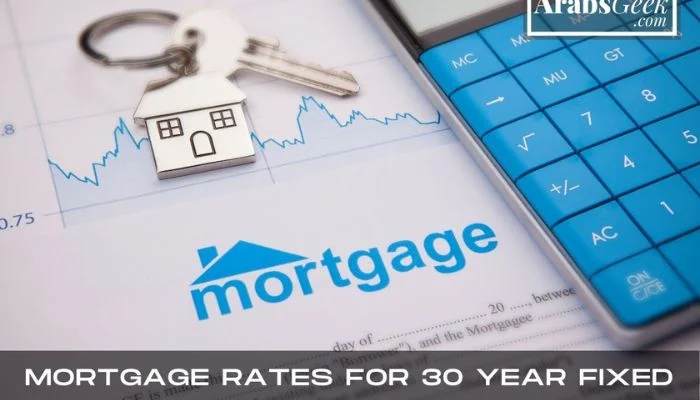Introduction | Mortgage Rates For 30 Year Fixed
Purchasing a home is one of the most significant financial decisions that many individuals will make in their lives. Choosing the right mortgage product can have a substantial impact on the long-term cost of homeownership. This article will explore the world of 30-year fixed mortgage rates, including the pros and cons, factors that influence them, and tips for finding the best rates for your needs. Whether you’re a first-time homebuyer or looking to refinance, this comprehensive guide will provide valuable insights into this popular mortgage option.
Table of Contents
What is a 30-Year Fixed Mortgage Rate?
A 30-year fixed mortgage rate is a loan where the interest rate remains the same for the entire 30-year term. This means that your monthly payments will not change, providing predictability and stability throughout the life of the loan. The interest rates for 30-year fixed mortgages are often higher than those for shorter-term loans or adjustable-rate mortgages, but the consistent payments make them attractive for many homebuyers.
For any business enquiry, you can contact us at ArabsGeek.com
For more of such financial articles, Consider visiting our sister website at EntrepreneursPilot.com
Historical Trends of 30-Year Fixed Mortgage Rates
Over the past several decades, mortgage rates have experienced periods of high volatility and extended periods of relative stability. Mortgage rates reached their peak in the early 1980s, with 30-year fixed rates exceeding 18%. Since then, rates have generally trended downward, reaching historic lows in recent years. These fluctuations in mortgage rates have been influenced by various economic factors and market trends.
Factors Influencing 30-Year Fixed Mortgage Rates
1. Inflation
Inflation, or the general increase in the price of goods and services, can impact mortgage rates. As inflation increases, lenders typically demand higher interest rates to compensate for the decrease in purchasing power.
2. Economic Growth | Mortgage Rates For 30 Year Fixed
Strong economic growth can lead to higher mortgage rates as demand for credit increases. Conversely, slower economic growth or a recession can cause mortgage rates to fall as lenders try to stimulate borrowing.
3. Federal Reserve Monetary Policy
The Federal Reserve’s monetary policy decisions can also influence mortgage rates. When the Fed raises or lowers the federal funds rate, it can indirectly affect mortgage rates. Although the federal funds rate and mortgage rates are not directly linked, they often move in the same direction as lenders adjust their rates to reflect the broader economic environment.
4. Bond Market | Mortgage Rates For 30 Year Fixed
Mortgage rates are also influenced by the bond market, particularly the yields on U.S. Treasury bonds. When bond yields increase, mortgage rates typically follow suit, as lenders look to maintain a competitive return on their investments.
5. Housing Market | Mortgage Rates For 30 Year Fixed
The health of the housing market can also affect mortgage rates. When demand for homes is high, lenders may raise mortgage rates to capitalize on the increased demand. On the other hand, if the housing market cools, mortgage rates may decrease as lenders try to attract borrowers.
Pros of 30-Year Fixed Mortgage Rates
1. Predictable Payments
One of the most significant advantages of a 30-year fixed mortgage is the predictability of the monthly payments. With a fixed interest rate, your monthly payment will remain the same throughout the life of the loan, allowing you to budget more effectively.
2. Lower Monthly Payments | Mortgage Rates For 30 Year Fixed
Since the loan term is spread over 30 years, monthly payments for a 30-year fixed mortgage are lower than those for shorter-term loans. This can make homeownership more affordable for some borrowers.
3. Tax Deductible Interest
The interest paid on a 30-year fixed mortgage is tax-deductible, which can help to reduce your overall tax liability.
Cons of 30-Year Fixed Mortgage Rates
1. Higher Interest Rates
Compared to shorter-term loans, 30-year fixed mortgages generally have higher interest rates. This means you’ll end up paying more in interest over the life of the loan.
2. Slower Equity Building | Mortgage Rates For 30 Year Fixed
With a 30-year fixed mortgage, you’ll build equity in your home at a slower pace than with a shorter-term loan. This is because a larger portion of your monthly payment goes towards interest, especially in the early years of the loan.
3. Longer Loan Term
The longer loan term means you’ll be making mortgage payments for an extended period, which may not be appealing to some borrowers.
Comparing 30-Year Fixed Mortgage Rates with Other Mortgage Options
1. 15-Year Fixed Mortgage Rates
A 15-year fixed mortgage has a shorter loan term and typically lower interest rates compared to a 30-year fixed mortgage. However, monthly payments are higher due to the shorter repayment period. This option can be beneficial for those who want to pay off their mortgage faster and build equity more quickly.
2. Adjustable-Rate Mortgages (ARMs) | Mortgage Rates For 30 Year Fixed
Adjustable-rate mortgages have interest rates that can change over time, based on market conditions. While the initial interest rate may be lower than that of a 30-year fixed mortgage, the rate can increase or decrease over the life of the loan, resulting in less predictable monthly payments.
How to Shop for the Best 30-Year Fixed Mortgage Rates
1. Improve Your Credit Score
A higher credit score can help you secure a lower interest rate on your mortgage. To improve your credit score, make sure to pay your bills on time, reduce your debt, and review your credit report for any errors.
2. Save for a Down Payment
A larger down payment can help you secure a lower mortgage rate, as it reduces the lender’s risk. Aim to save at least 20% of the home’s purchase price for a down payment.
3. Pay Off Debt | Mortgage Rates For 30 Year Fixed
Reducing your debt-to-income ratio can make you a more attractive borrower and help you secure a lower mortgage rate. Focus on paying off high-interest debt, such as credit cards, before applying for a mortgage.
4. Compare Lenders and Loan Offers
Shop around and compare mortgage rates from multiple lenders. Don’t be afraid to negotiate with lenders to secure the best possible rate. Remember to factor in closing costs and other fees when comparing loan offers.
Locking in Your 30-Year Fixed Mortgage Rate
Once you’ve found a competitive mortgage rate, you may want to consider locking it in. A rate lock guarantees the interest rate for a specific period, typically 30 to 60 days, protecting you from potential rate increases while you complete the home-buying process.
When to Refinance Your 30-Year Fixed Mortgage
Refinancing your 30-year fixed mortgage can be an effective strategy to lower your interest rate, reduce your monthly payments, or shorten your loan term. Consider refinancing if interest rates have dropped significantly since you took out your original mortgage or if your credit score has improved, potentially qualifying you for a better rate.
Conclusion | Mortgage Rates For 30 Year Fixed
The 30-year fixed mortgage is a popular choice for many homebuyers due to its predictable payments and lower monthly costs. However, it’s essential to carefully consider the pros and cons, as well as explore other mortgage options, before committing to a long-term loan. By doing your research, improving your credit score, and shopping around for the best rates, you can maximize the financial benefits of homeownership and make an informed decision about the best mortgage product for your needs.
Frequently Asked Questions (FAQs)
Q1: Can I pay off my 30-year fixed mortgage early?
Yes, you can make extra payments towards the principal balance of your loan to pay it off early. However, be sure to check with your lender about any prepayment penalties that may apply.
Q2: How does my credit score affect my 30-year fixed mortgage rate?
Lenders use your credit score as a measure of creditworthiness, with higher scores generally resulting in lower mortgage rates. Improving your credit score can help you secure better terms and lower interest rates on your mortgage.
Q3: Can I switch from a 30-year fixed mortgage to a 15-year fixed mortgage?
Yes, you can refinance your 30-year fixed mortgage to a 15-year fixed mortgage, which may result in lower interest rates and faster equity building. However, keep in mind that your monthly payments will likely increase due to the shorter loan term.
Q4: Are 30-year fixed mortgage rates negotiable?
Mortgage rates can be negotiable to some extent. You can shop around and compare rates from different lenders, and don’t hesitate to ask for a better rate if you believe you qualify for one.
Q5: Should I choose a 30-year fixed mortgage or an adjustable-rate mortgage?
The choice between a 30-year fixed mortgage and an adjustable-rate mortgage depends on your financial situation, risk tolerance, and long-term goals. A 30-year fixed mortgage offers predictability and stability, while an adjustable-rate mortgage may initially have lower interest rates but can change over time. Consider your unique circumstances and preferences before making a decision.











